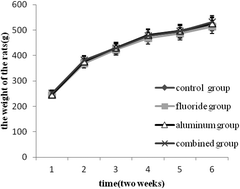Pathological changes and effect on the learning and memory ability in rats exposed to fluoride and aluminum
Abstract
Background: The aim of this study is to establish a single and combined intoxication model of fluoride and aluminum so as to observe the impact of these chemicals on the learning and memory ability and the pathologic changes in the brains of rats. Methods: Forty male Wistar rats were randomly assigned into control (distilled water), fluoride (50 mg L−1 F−), aluminum (100 mg L−1 Al3+) and combined groups (50 mg L−1 F− and 100 mg L−1 Al3+). The experiment lasted for 3 months. The short-term memory ability and learning and memory ability of the rats were assessed using Y maze and Morris water maze, respectively. At the same time, the concentrations of fluoride and aluminum in urine and brain were measured. The pathologic and microstructural changes in the hippocampus were observed via optical microscopy and transmission electron microscopy, and the expression of the Aβ1–42 protein was detected using immunohistochemistry. Results: The results showed that the learning and memory ability of each toxicant-exposed group was decreased; the most severe was in the aluminum group, followed by the combined group, and the lightest was in the fluoride group. Although there was no significant difference between all the groups, both fluoride and aluminum could lower the short-term memory ability of the rats. In addition, different pathologic and microstructural changes were observed in fluoride, aluminum and combined groups. Compared with the control group, the expression of Aβ1–42 protein in the aluminum group was highest, followed by the combined group, and that in the fluoride group was lowest. Conclusions: In conclusion, combined intake of fluoride and aluminum may alleviate the deficits to learning and memory ability caused by aluminum intoxication.


 Please wait while we load your content...
Please wait while we load your content...